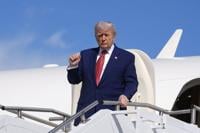WASHINGTON - Countries around the world — Canada included — are waiting anxiously as the U.S. Supreme Court considers whether President Donald Trump has the authority to continue using his favoured tariff tool.
No matter which way the court jumps, however, the Trump administration is expected to maintain some level of tariffs on the United States' trade partners.
Trump told reporters in the Oval Office on Thursday it would be "devastating" for the country if the top court rules against him, "but I also think we will have to develop a game two plan."
The conservative-led U.S. Supreme Court heard arguments Wednesday related to two separate legal challenges of Trump's use of the International Emergency Economic Powers Act for tariffs.
Trump used the national security statute, better known as IEEPA, to impose his so-called "Liberation Day" tariffs and fentanyl-related duties on Canada, Mexico and China.
Trump's top Supreme Court lawyer, Solicitor General D. John Sauer, faced pointed questions when he appeared before the court Wednesday. Several justices voiced skepticism about the president's use of IEEPA when the statute itself does not include the word "tariff" or any of its synonyms.
The justices closely examined the language in the act — particularly the wording about the president's power to "regulate" imports — to determine whether that allows for Trump's wide-ranging tariffs.
Sauer argued that Trump is using IEEPA to regulate foreign commerce rather than raise money — despite Trump's repeated public claims that the duties are making America rich.
The U.S. Constitution reserves power over taxation and tariffs for Congress. The justices wrestled with the broader implications of handing wide-ranging tariff powers to the president.
Trump appointee Justice Neil Gorsuch suggested that once that power was given to a president, it would be next to impossible for Congress to get it back.
"It's a one-way ratchet toward the gradual but continual accretion of power in the executive branch and away from the people’s elected representatives," Gorsuch said.
The lawyers arguing against Trump's tariffs were also challenged by the justices on the broad language in IEEPA, said King & Spalding partner Ryan Majerus, a former assistant general counsel at the Office of the U.S. Trade Representative during the first Trump administration.
The conservative majority justices on the Supreme Court have been hesitant to rein in the unprecedented expansion of executive power during Trump's second term.
But during Wednesday's hearing, Supreme Court conservatives Gorsuch, Chief Justice John Roberts and Justice Amy Coney Barrett all hinted they were reluctant to endorse the Trump administration's sweeping interpretation of the president's tariff powers — suggesting they could join the three liberal justices in limiting those powers.
America's top court could have until June to issue a ruling but it's expected to come sooner.
Majerus said he's not convinced the court will go so far as to rule that IEEPA never allows tariffs.
The justices might conclude that IEEPA is broad enough to allow tariffs in certain instances, he said — but they might also set guardrails or require that tariffs be more clearly tethered to the specific emergency cited by the president.
"It seems plausible to think that that will mean a huge chunk, if not all of the tariffs imposed by the president ... didn't meet that test," said Majerus, who is also a former assistant secretary for enforcement and compliance at the U.S. Department of Commerce's international trade administration.
That could fully nullify the 35 per cent economywide tariffs on Canada. Those duties do not apply to goods compliant with the Canada-U.S.-Mexico Agreement on trade.
Trump would not say Thursday which tariff options he's considering if the court rules against him — but he does have options.
Congress has passed laws over the past century that allow the president some control over tariffs in certain situations — but they all have more restrictions than IEEPA.
Trump might turn to Section 338 of the Tariff Act of 1930, which allows a president to hit countries with tariffs of up to 50 per cent if they're treating imports from other countries more favourably than products from the United States. Section 338 has never been used by a president before.
There's also Section 301 of the Trade Act of 1974, which allows tariffs if an investigation finds a trading partner's policies are unreasonable and discriminatory. That law requires country-by-country investigations of trade policy before a tariff can be imposed.
Section 122 of the Trade Act of 1974 allows tariffs of up to 15 per cent to address large and serious balance-of-payments deficits. Those tariffs can only stay in place for 150 days before they require congressional approval to continue.
Majerus said he thinks the Trump administration would look to Section 122 for an immediate 15 per cent tariff and then launch country-focused Section 301 investigations.
"I think that they'll launch countrywide investigations covering seven or eight of our biggest trading partners," Majerus said. "So I would envision Canada is a possibility."
The Supreme Court’s decision will not affect Trump's expanding use of tariffs under Section 232 of the Trade Expansion Act of 1962 — tariffs that are already hammering Canada's steel, aluminum, automobile, lumber and copper industries.
Trump has indicated he plans to target more industries with these duties.
This report by şĂÉ«tvwas first published Nov. 6, 2025.
— With files from The Associated Press














































